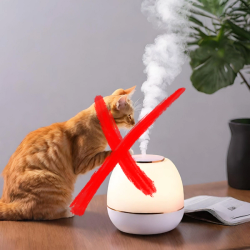FeLV and FIV
FeLV and FIV are tested together as though they are parts of the same disease. Although they have many similarities, there are also major differences. The following is a comparison of these viruses:
FeLV is second only to trauma as the leading cause of death in cats globally, killing 85% of persistently infected felines within three years of diagnosis. However, less than 1% of healthy indoor cats in the US are infected. The majority of cats who are exposed to the virus can resist infection or eliminate the virus on their own (this is especially true for cats that are free of parasites, are current on their routine vaccines, and are fed a good diet). The cats most at risk are stray cats who already have a weakened immune system due to other illnesses or malnutrition. Cats exposed to FeLV may develop one of three outcomes: abortive (the virus is readily eliminated and never detectable), regressive (the cat’s immune system suppresses the virus so that they do not have symptoms, are negative on subsequent tests and are at low risk of transmitting the disease to other cats) or progressive (associated with conditions such as profound anemia or lymphoma, but because it suppresses the immune system, it can also predispose cats to deadly infections).
FIV has the potential to eventually compromise a cat’s immune system and reduce its ability to fight off illnesses, it is characterized by a long delay in the onset of symptoms after infection. There are a few different stages of FIV: The acute phase occurs after initial infection. Some cats will experience lethargy, fever, or lymph node enlargement (this stage lasts one to three months); the latent infection period has no symptoms (this stage can last from months to years and the vast majority of cats - more than 80% - will not progress beyond this stage); if a cat reaches the Feline Acquired Immunodeficiency Syndrome (Feline AIDS) phase, they are susceptible to secondary disease. During this time, they can develop severe infections, cancer, neurologic disease, immune-mediated disease, etc.
Similarities between FeLV and FIV:
They are both specific to members of the cat family. There is no evidence that either FeLV or FIV can be transmitted to humans or other mammals. Both are retroviruses, which means they can make a copy of the virus and integrate it into the host cell’s DNA. Both are common viruses - recent studies estimate a prevalence of 2.3% (FeLV) and 2.5% (FIV) in cats in the US. Both affect the immune system and, like thousands of viruses in cats and humans, there is no cure and no specific treatment, except for good care.
Differences between FeLV and FIV:
Level of contagion:
FeLV is highly contagious. It has been referred to as the ‘friendly cat’ disease because it's easily spread from cat to cat through contact that shares saliva, nasal secretions, urine, feces, and milk. It may be transmitted through mutual grooming, from mother to kitten, bite wounds, or even rarely through shared litter boxes and feeding dishes.
FIV is difficult to spread and does not survive for more than a few hours in the environment (air, light, heat, and regular household disinfectants can kill it). Saliva from an infected cat is the primary mode of transmission. It is generally transmitted by a deep bite, and bites of that kind are rare. The most frequently infected cats are typically outdoor, un-neutered, aggressive male cats.
Predicted Lifespan:
FeLV has a median survival of 2.5 years; however, during the early stages of infection, they may not display any symptoms, and they can live several years in good health if they are provided with excellent care.
FIV is a slowly developing virus that could (but rarely does) eventually allow a disease to progress unchecked. Studies conducted in 2010 and 2022 found that an FIV diagnosis wasn't associated with decreased life spans. These cats have an excellent chance of living as long, and as healthy, a life as non-infected cats and ultimately die of the same causes as uninfected cats.
Whiskers, Paws & Love Recommendations:
It can be an extremely rewarding experience to adopt a FeLV-positive cat. While it’s true that they may have a shorter life span and require more veterinary care than other cats, they still have plenty of love to offer and their remaining years can be worthwhile, with many good experiences and memories. Ideal owners of cats with feline leukemia live in a home without other cats (although it’s fine to have dogs and other pets), or they can live with other cats who are FeLV positive. If you are able to provide a loving home, cover the cost of regular vet visits, and ensure that your cat won’t roam outdoors, you should consider adopting a FeLV-positive cat.
We absolutely recommend adopting an FIV-positive cat since they usually live as long and healthy a life as non-infected cats and don’t generally require more care than other cats. But that doesn’t mean that they will never become ill. Illnesses can be easier to catch and harder to fight off. If they become ill, they will probably need to be treated earlier, longer, and more aggressively than cats who are not FIV positive. They should see the vet at the first sign of illness and may be prescribed stronger medication for a longer time.
FeLV positive or FIV positive, and ALL other cats need to be:
- Spayed or neutered
- Fed the best quality diet of wet food you can afford (making sure to avoid raw diets for immunocompromised cats)
- Kept indoors and/or in an outdoor cat-proofed area
- Given regular vet exams, dental cleanings, and treatment of any health problems when they arise
- Shielded from high-stress levels
- LOVED!




